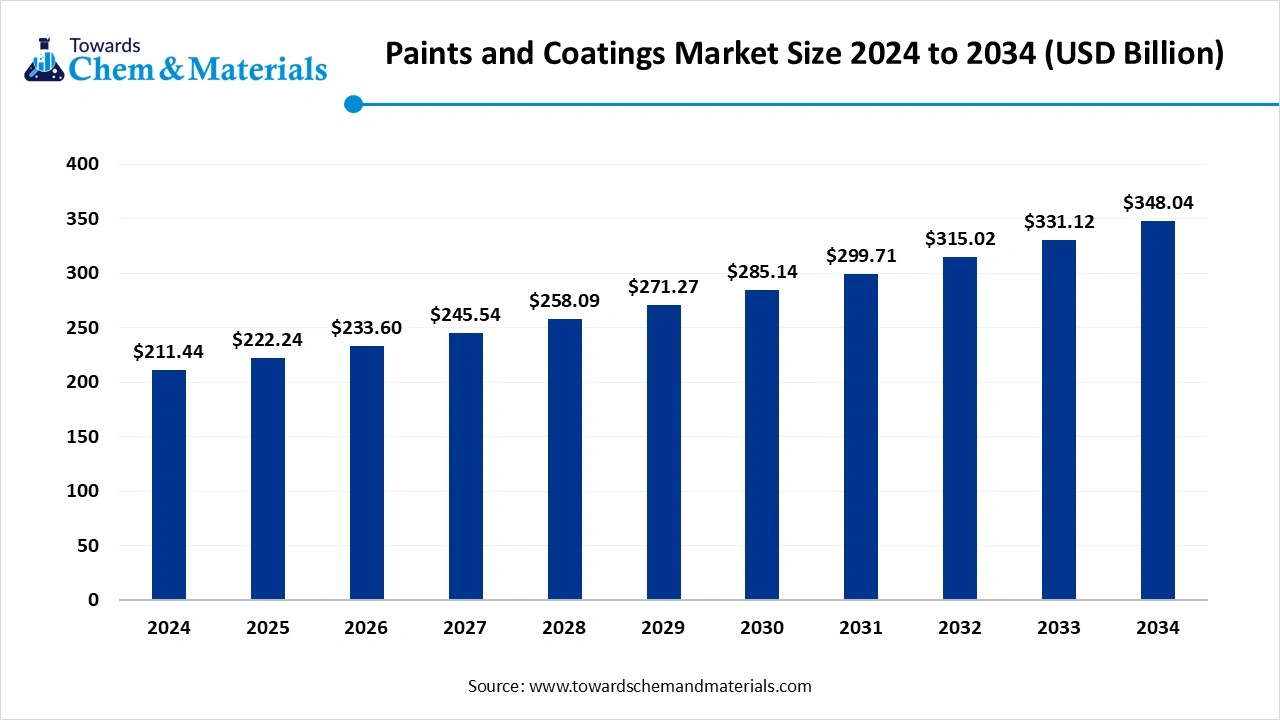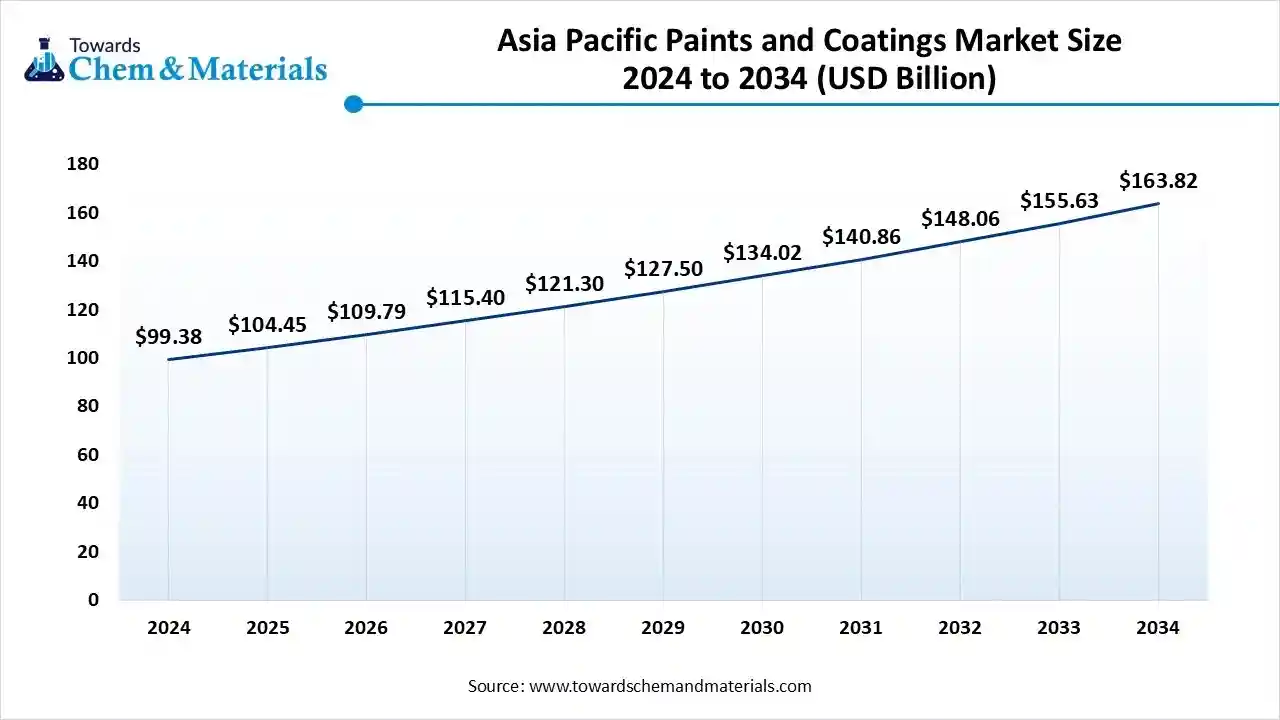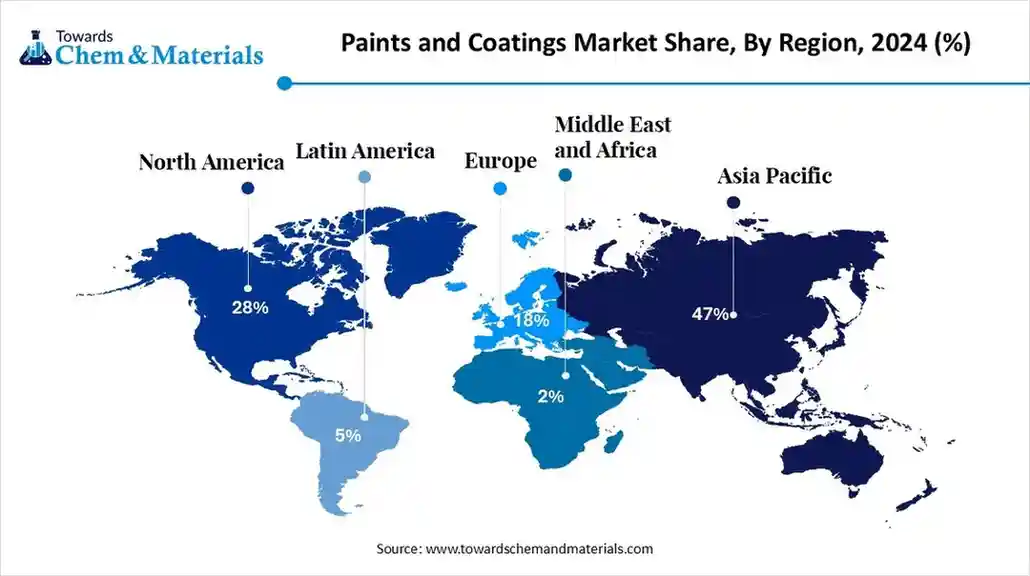November 2025
The global paints and coatings market size was valued at USD 211.44 billion in 2024 and is expected to hit around USD 348.04 billion by 2034, growing at a compound annual growth rate (CAGR) of 5.11% over the forecast period from 2025 to 2034. The growth of the market is driven by the rising demand from various sectors, which drives the growth.

The global paints and coatings market involves the production and application of liquid, powder, or semi-liquid coatings applied to surfaces to provide protection, decoration, and functional properties. These coatings are used across multiple industries, including automotive, construction, industrial, and consumer goods, to enhance durability, aesthetics, and performance. Market growth is driven by increasing urbanisation, industrialisation, demand for eco-friendly waterborne coatings, and technological innovations like UV-curable and high-solids coatings.
Key technological shifts in the paints and coatings market include the development of sustainable, eco-friendly products like low-VOC and waterborne coatings, and the integration of digital technologies for product development and manufacturing. Additionally, advanced smart and intelligent coatings with functionalities such as self-healing, antimicrobial, and colour-changing properties are becoming more common, along with the use of nanotechnology to improve durability and performance.
| Report Attributes | Details |
| Market Size in 2026 | USD 233.60 Billion |
| Expected Size by 2034 | USD 348.04 Billion |
| Growth Rate from 2025 to 2034 | CAGR 5.11% |
| Base Year of Estimation | 2024 |
| Forecast Period | 2025 - 2034 |
| Dominant Region | Asia Pacific |
| Segment Covered | By Resin Type, By Technology, By Application, By End-Use Industry, By Region |
| Key Companies Profiled | Sherwin-Williams: , PPG Industries, AkzoNobel, BASF SE , Axalta Coating Systems , RPM International Inc., Nippon Paint Holdings , Kansai Paint Co., Ltd. , Jotun Group , Hempel A/S , Asian Paints Limited , Berger Paints India Ltd. ,DuluxGroup , Valspar Corporation , Tikkurila Oyj |
| Region / Country | Regulatory Body | Key Regulations / Standards | Focus Areas | Notable Notes |
| United States | Environmental Protection Agency (EPA), Occupational Safety and Health Administration (OSHA), Consumer Product Safety Commission (CPSC) | - Clean Air Act (CAA) – VOC and HAP limits - Toxic Substances Control Act (TSCA) - OSHA Hazard Communication Standard (29 CFR 1910.1200) - EPA Method 24 (VOC determination) |
- VOC and hazardous air pollutant limits - Chemical inventory and labelling - Worker safety and exposure limits |
EPA enforces VOC limits for architectural and industrial coatings. TSCA requires pre-manufacture notification for new chemicals. Lead-based paints are banned under CPSC rules. |
| European Union | European Chemicals Agency (ECHA), European Commission (DG ENV), European Committee for Standardisation (CEN) | - REACH Regulation (EC 1907/2006) - CLP Regulation (EC 1272/2008) - VOC Directive (2004/42/EC) - EcoLabel Regulation (EC 66/2010) |
- Chemical safety and registration - VOC content limits - Labelling and classification - Green product certification |
REACH ensures registration of paint ingredients. The EU VOC Directive sets VOC content limits in grams per litre for different coating types. EcoLabel promotes sustainable, low-emission paints. |
| China | Ministry of Ecology and Environment (MEE), State Administration for Market Regulation (SAMR), Standardisation Administration of China (SAC) | - GB 18582-2021 – VOC limits for interior coatings - GB 30981-2020 – VOC limits for industrial coatings - Measures for Environmental Management of New Chemical Substances (MEE Order No. 12) |
- VOC control - New chemical approval - Product labelling and safety |
China enforces one of the strictest VOC policies in Asia. The new GB standards align with EU VOC benchmarks and promote waterborne and UV-cured coatings. |
| India | Bureau of Indian Standards (BIS), Ministry of Environment, Forest and Climate Change (MoEFCC), Central Pollution Control Board (CPCB) | - BIS IS 15489:2004 – VOC limits for paints - Hazardous and Other Wastes (Management and Transboundary Movement) Rules, 2016 - Chemical (Management and Safety) Rules, 2020 (proposed) |
- VOC limits and labelling - Hazardous waste disposal - Lead and heavy metal restrictions |
India is adopting the EU-style REACH framework. Several states have imposed lead paint bans. CPCB promotes low-VOC and eco-label paint formulations. |
| Japan | Ministry of the Environment (MOE), Ministry of Economy, Trade and Industry (METI), Japanese Industrial Standards Committee (JISC) | - Air Pollution Control Law (VOC Regulation) - Chemical Substances Control Law (CSCL) - JIS K 5660, K 5663 – standards for paints and varnishes |
- VOC emission limits - Chemical risk evaluation - Product performance standards |
Japan’s laws require VOC abatement in paint manufacturing and automotive refinishing. CSCL governs chemical safety similarly to REACH. |
| Middle East (UAE, Saudi Arabia) | Emirates Authority for Standardization and Metrology (ESMA), Saudi Standards, Metrology and Quality Organization (SASO) | - ESMA UAE.S 5010:2018 – VOC limits and labeling - SASO 2879:2021 – VOC standards for paints and varnishes |
- VOC content control - Product certification - Green building compliance |
GCC countries are aligning with EU VOC standards. Paints must meet LEED and Estidama green building requirements. |
How Did The Acrylic Segment Dominate The Paints And Coatings Market In 2024?
The acrylic segment dominated the market with a share of approximately 47.5% in 2024. Acrylic resins are widely used in paints and coatings due to their excellent UV resistance, colour retention, and quick-drying properties. They dominate architectural and decorative coatings, providing superior weather protection. The growing shift toward waterborne acrylic formulations supports eco-friendly applications in the construction and automotive sectors globally.
The epoxy segment is expected to grow significantly in the market during the forecast period. Epoxy-based coatings are preferred for their exceptional chemical, abrasion, and corrosion resistance. They are extensively used in industrial, marine, and automotive applications where durability is critical. Epoxy coatings also offer excellent adhesion to metal surfaces, making them ideal for protective coatings in infrastructure and heavy-duty environments.
Which Technology Segment Dominates The Paints And Coatings Market In 2024?
The water-based segment dominated the market with a share of approximately 41.3% in 2024. Water-based coating technologies are gaining prominence due to their low VOC content and compliance with environmental regulations. They are widely used in residential and industrial applications for their ease of application, fast drying, and minimal odour.
Ongoing advancements have improved performance in corrosion resistance and durability. The UV-cured coatings segment is expected to grow in the forecast period. UV-cured coatings offer superior hardness, chemical resistance, and rapid curing times, enhancing productivity across manufacturing lines. These coatings are increasingly used in electronics, furniture, and automotive components. Their energy efficiency and ability to provide high-gloss, scratch-resistant finishes make them a sustainable choice for modern applications.
How Did the Agricultural Coatings Segment Dominate The Paints And Coatings Market In 2024?
The architectural coatings segment dominated the market with a share of approximately 48.97% in 2024. Architectural coatings form the largest application segment, driven by global urbanisation and rising construction activities. These coatings provide decorative appeal and protection against moisture, UV radiation, and wear. Increasing demand for low-odour, washable, and sustainable paints continues to influence the product development strategies of major players.
The automotive coatings segment is expected to grow in the forecast period. Automotive coatings are vital for aesthetic enhancement and corrosion protection of vehicles. The growing EV market and technological innovation in lightweight materials have led to advanced coatings with heat resistance and superior adhesion. OEM and refinish coatings demand continues to rise with automotive production growth worldwide.
Which End Use Industry Segment Dominates The Paints And Coatings Market In 2024?
The construction segment dominated the market with a share of approximately 50% in 2024. The construction sector drives paints and coatings demand through large-scale infrastructure, commercial, and residential projects. Increasing emphasis on durability, thermal insulation, and eco-friendly coatings fuels market growth. Technological advancements in smart coatings with self-cleaning or anti-bacterial properties are also gaining attention in modern construction applications.
The automotive segment is expected to grow in the forecast period. In the automotive industry, coatings are used for protection, aesthetic appeal, and longevity. The trend toward lightweight vehicles, electric mobility, and sustainable manufacturing promotes the use of high-performance and UV-cured coatings. Growing automotive production in emerging markets continues to enhance the overall demand for advanced coating systems.
The Asia Pacific paints and coatings market size is estimated at USD 104.45 billion in 2025 and is projected to reach USD 348.04 billion by 2034, growing at a CAGR of 5.11% from 2025 to 2034. Asia Pacific dominated the market with a share of approximately 47% in 2024.

Asia Pacific dominates the market owing to strong growth in the construction, automotive, and industrial sectors. Rapid urbanisation in China, India, and Southeast Asia boosts demand for decorative and protective coatings. Increasing infrastructure investment and preference for water-based, low-VOC coatings are accelerating market expansion in the region.
India Has Seen Growth Driven By The Expanding Automotive Industry.
India represents one of the fastest-growing markets in Asia, driven by housing development, commercial real estate, and the expanding automotive industry. Rising disposable income and urban lifestyle shifts are increasing decorative paint consumption. Additionally, the government's infrastructure initiatives and manufacturing growth support industrial coating demand.
North America Paints And Coatings Market Analysis.
North America has seen significant growth in the market in the forecast period. North America’s paints and coatings market benefits from advanced technological innovation, sustainability initiatives, and strong automotive and aerospace sectors. The demand for high-performance coatings with corrosion resistance, low emissions, and UV stability continues to grow. Stringent environmental regulations are also driving a transition toward waterborne and UV-cured coating technologies.
U.S. Growth In The Market Is Driven By The Growing Adoption Of Eco-Friendly Materials.
The U.S. dominates the North American paints and coatings market due to high investments in R&D and robust industrial activity. Adoption of eco-friendly, low-VOC coatings is increasing in residential and commercial construction. Moreover, technological advancements in smart and self-healing coatings are shaping the market’s premium segment.
Europe Paints And Coatings Market Trends
Europe has seen notable growth in the market. Europe’s paints and coatings market emphasises sustainability, innovation, and regulatory compliance. Demand for advanced coating technologies such as UV-cured and powder coatings is rising, driven by environmental legislation. The region’s construction recovery, coupled with strong demand from the automotive and industrial manufacturing sectors, supports stable market performance.

UK Green Building Initiatives Drive The Growth.
The UK market focuses on premium architectural coatings and automotive refinishing solutions. Green building standards and eco-label certifications are influencing manufacturers to develop water-based and bio-based products. Additionally, renovation projects and electric vehicle production are increasing the demand for advanced, high-durability, and energy-efficient coating formulations.
By Resin Type
By Technology
By Application
By End-Use Industry
By Region
November 2025
November 2025
November 2025
November 2025